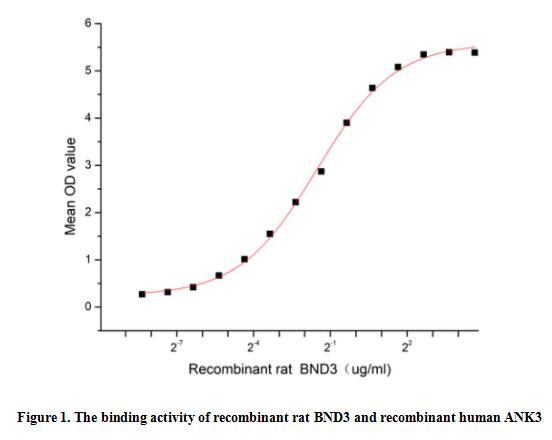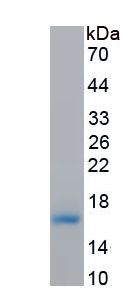Active Band 3 (BND3)
CD233; SLC4A1; SLC4-A1; WD; AE1; DI; EMPB3; EPB3; FR; RTA1A; SW; WD1; WR; Anion Exchange Protein 1; Solute Carrier Family 4,Anion Exchanger,Member 1; Erythrocyte Membrane Protein Band 3
- Product No.APB681Ra01
- Organism SpeciesRattus norvegicus (Rat) Same name, Different species.
- Buffer FormulationPBS, pH7.4, containing 0.01% SKL, 5% Trehalose.
- Traits Freeze-dried powder
- Purity> 95%
- Isoelectric Point10.6
- ApplicationsCell culture; Activity Assays.
- DownloadInstruction Manual
- UOM 10µg50µg 200µg 1mg 5mg
- FOB
US$ 260
US$ 650
US$ 1300
US$ 3900
US$ 9750
For more details, please contact local distributors!
ACTIVITY TEST

Band 3 (BND3), also known as Anion Exchanger 1 and SLC4A1, is a 90-100 kDa polytropic membrane protein that is part of the anion exchanger (AE) family and is expressed in the erythrocyte plasma membrane, where it mediates the exchange of the cellular HCO3- with CI- in plasma. BND3 is required for normal flexibility and stability of the erythrocyte membrane and for normal erythrocyte shape via the interactions of its cytoplasmic domain with cytoskeletal proteins, glycolytic enzymes, and hemoglobin. Scaffold protein Ankyrin 3, Node Of Ranvier (ANK3) can Interacts with BND3, thus a functional binding ELISA assay was conducted to detect the interaction of recombinant rat BND3 and recombinant human ANK3. Briefly, biotin-linked BND3 were diluted serially in PBS, with 0.01% BSA (pH 7.4). Duplicate samples of 100 ul were then transferred to ANK3-coated microtiter wells and incubated for 1h at 37℃. Wells were washed with PBST 3 times and incubation with Streptavidin-HRP for 30min, then wells were aspirated and washed 5 times. With the addition of substrate solution, wells were incubated 15-25 minutes at 37℃. Finally, add 50 µl stop solution to the wells and read at 450 nm immediately. The binding activity of recombinant rat BND3 and recombinant human ANK3 was shown in Figure 1, the EC50 for this effect is 0.35 ug/mL.
USAGE
Reconstitute in 10mM PBS (pH7.4) to a concentration of 0.1-1.0 mg/mL. Do not vortex.
STORAGE
Avoid repeated freeze/thaw cycles. Store at 2-8°C for one month. Aliquot and store at -80°C for 12 months.
STABILITY
The thermal stability is described by the loss rate. The loss rate was determined by accelerated thermal degradation test, that is, incubate the protein at 37°C for 48h, and no obvious degradation and precipitation were observed. The loss rate is less than 5% within the expiration date under appropriate storage condition.
GIVEAWAYS
INCREMENT SERVICES
-
 BCA Protein Quantification Kit
BCA Protein Quantification Kit
-
 Molecular Mass Marker for Protein
Molecular Mass Marker for Protein
-
 Monoclonal Antibody Customized Service
Monoclonal Antibody Customized Service
-
 Polyclonal Antibody Customized Service
Polyclonal Antibody Customized Service
-
 Protein Activity Test Experiment Service
Protein Activity Test Experiment Service
-
 Electrophoretic Mobility Shift Assay (EMSA) Experiment Service
Electrophoretic Mobility Shift Assay (EMSA) Experiment Service
-
 Buffer
Buffer
-
 Lentivirus Packaging Experiment Service
Lentivirus Packaging Experiment Service
-
 Adenovirus Packaging Experiment Service
Adenovirus Packaging Experiment Service
-
 Real Time PCR Experimental Service
Real Time PCR Experimental Service
-
 Spike RBD Protein (S-RBD)
Spike RBD Protein (S-RBD)
-
 Protein G
Protein G
-
 Protein A
Protein A
| Catalog No. | Related products for research use of Rattus norvegicus (Rat) Organism species | Applications (RESEARCH USE ONLY!) |
| RPB681Ra01 | Recombinant Band 3 (BND3) | Positive Control; Immunogen; SDS-PAGE; WB. |
| APB681Ra01 | Active Band 3 (BND3) | Cell culture; Activity Assays. |
| RPB681Ra02 | Recombinant Band 3 (BND3) | Positive Control; Immunogen; SDS-PAGE; WB. |
| PAB681Ra01 | Polyclonal Antibody to Band 3 (BND3) | WB; IHC; ICC; IP. |







